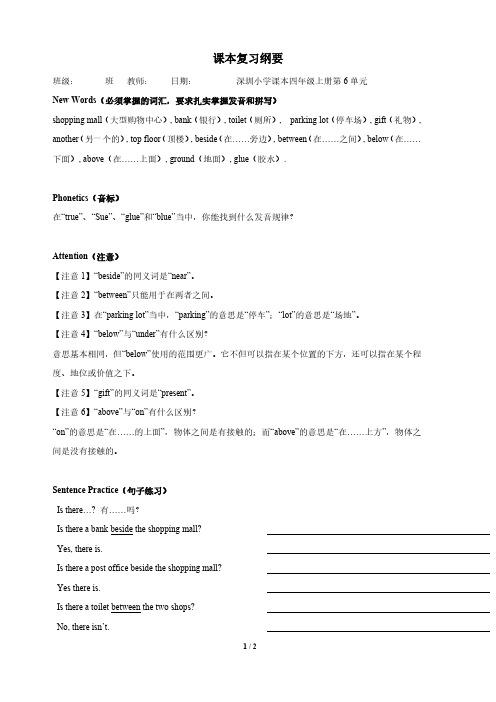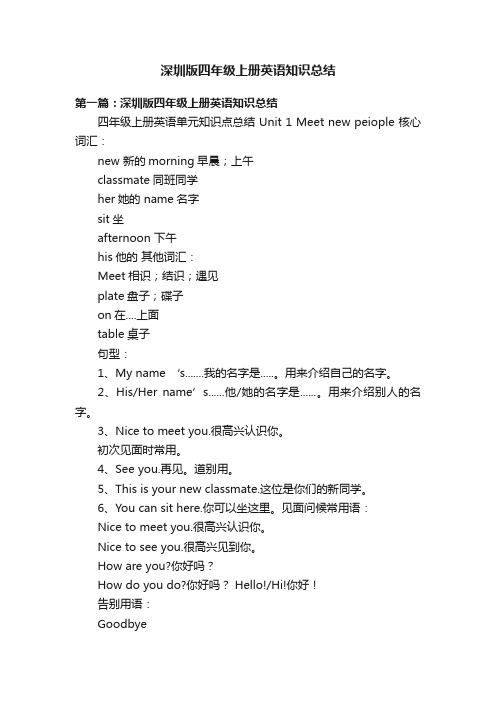深圳小学四年级英语上册知识点汇总范文
- 格式:doc
- 大小:43.00 KB
- 文档页数:11

课本复习纲要班级:班教师:日期:深圳小学课本四年级上册第6单元New Words(必须掌握的词汇,要求扎实掌握发音和拼写)shopping mall(大型购物中心), bank(银行), toilet(厕所), parking lot(停车场), gift(礼物), another(另一个的), top floor(顶楼), beside(在……旁边), between(在……之间), below(在……下面), above(在……上面), ground(地面), glue(胶水).Phonetics(音标)在“true”、“Sue”、“glue”和“blue”当中,你能找到什么发音规律?Attention(注意)【注意1】“beside”的同义词是“near”。
【注意2】“between”只能用于在两者之间。
【注意3】在“parking lot”当中,“parking”的意思是“停车”;“lot”的意思是“场地”。
【注意4】“below”与“under”有什么区别?意思基本相同,但“below”使用的范围更广。
它不但可以指在某个位置的下方,还可以指在某个程度、地位或价值之下。
【注意5】“gift”的同义词是“present”。
【注意6】“above”与“on”有什么区别?“on”的意思是“在……的上面”,物体之间是有接触的;而“above”的意思是“在……上方”,物体之间是没有接触的。
Sentence Practice(句子练习)Is there…? 有……吗?Is there a bank beside the shopping mall?Yes, there is.Is there a post office beside the shopping mall?Yes there is.Is there a toilet between the two shops?No, there isn’t.Is there a police station between the two cinemas? No, there isn’t.Is there a fast food restaurant on the first floor?Is there a bookshop on the second floor?Is there another bookshop on the top floor?Is there a parking lot below the block?Is there a gift below the table?Is there a plane above the school?Is there a fly above the table? I want to use glue to catch it.注意1,2,3,4,5,6Homework(家庭作业)1、必学单词抄四遍。

千里之行,始于足下。
四年级上册英语知识点归纳总结四年级上册英语知识点归纳总结四年级上册英语主要涵盖了以下几个方面的知识点:基本日常用语、数字、时间、周日、月份、身体部位、家庭成员、动物、食物、颜色、形状、天气、季节、节日、城市和国家等。
下面将根据这些知识点逐一进行总结。
基本日常用语:1. 问候语:Hello(你好), Hi(嗨), How are you?(你好吗?)2. 介绍自己:My name is...(我的名字是...), I am...(我是...)3. 道别语:Goodbye(再见), See you(再见)4. 礼貌用语:Please(请), Thank you(谢谢), Sorry(对不起)数字:1. 0-10的数字:zero(零), one(一), two(二), three(三),four(四), five(五), six(六), seven(七), eight(八), nine (九), ten(十)2. 可以根据这些数字拼写其他数字:eleven(十一), twelve(十二), thirteen(十三), twenty(二十), thirty(三十)等时间:1. 问时间:What time is it?(现在几点了?)2. 回答时间:It is...(现在是...点)周日:第1页/共3页锲而不舍,金石可镂。
1. Monday(星期一), Tuesday(星期二), Wednesday(星期三), Thursday(星期四), Friday(星期五), Saturday(星期六), Sunday(星期日)月份:1. January(一月), February(二月), March(三月), April(四月), May(五月), June(六月), July(七月), August(八月), September(九月), October(十月), November(十一月), December(十二月)身体部位:1. head(头), eyes(眼睛), ears(耳朵), nose(鼻子), mouth(嘴巴), teeth(牙齿), hand(手), arm(手臂), leg(腿), foot(脚)家庭成员:1. father(爸爸), mother(妈妈), sister(姐姐), brother(弟弟), grandmother(奶奶), grandfather(爷爷)动物:1. cat(猫), dog(狗), bird(鸟), fish(鱼), rabbit(兔子), monkey(猴子), tiger(老虎), elephant(大象), lion(狮子), panda (熊猫)食物:1. apple(苹果), banana(香蕉), orange(橙子), watermelon(西瓜), strawberry(草莓), bread(面包), cake(蛋糕), rice(米饭), noodles(面条)颜色:千里之行,始于足下。

小学四年级英语(上册)重要知识点归纳Unit 1 my classroomThis is my classroom. It's big. 这是我的教室。
它很大。
The door is green. The windows are yellow. 门是绿色的,窗户是黄色的。
Let's go and have a look. 让我们去看看吧!We have 6 new lights. 我们有六盏新灯。
Where's your seat It's near the door.你的座位在哪里在门附近。
Let's/ let me clean the board. 让我们/让我擦黑板。
Open the door翻开门Sweep the floor. 扫地。
Turn on the light. 翻开灯。
Put up the picture. 挂图画。
Clean the board. 擦黑板。
Clean the window 擦窗户。
重点词汇:Window board light picture door floor compute r teacher's desk wallfanUnit 2 my schoolbagI have a new schoolbag. 我有一个新书包。
What colour is it It's black and white. 它是什么颜色的它是黑白相间的。
My schoolbag is heavy. What's in it我的书包很重。
里面有什么Put your notebook in your bag. 把你的笔记本放进书包。
How many English books do you have I have 6. 你有多少英语书我有六本。
How many Chinese books can you see I can see 20.你能看见多少本语文书我能看见二十本。

四年级英语上册重点知识归纳四年级英语上册重点知识归纳:一、单词:1. 人称代词(主格):I(我),you(你),he(他),she(她),it (它),we(我们),you(你们),they(他们)。
2. 形容词性物主代词:my(我的),your(你的),his(他的),her (她的),its(它的),our(我们的),your(你们的),their(他们的)。
3. 名词性物主代词:mine(我的),yours(你的),herses(她的),his(他的),its(它的),ours(我们的),yours(你们的),theirs (他们的)。
4. 介词:in(在……里面),on(在……上面),under(在……下面),behind(在……后面)。
5. 指示代词:this(这个),that(那个)。
6. 方位介词:in front of(在……前面),behind(在……后面),next to (在……旁边)。
7. 序数词:first,second,third,fourth,fifth,sixth,seventh,eighth,ninth,tenth。
8. 特殊疑问词:what(什么),why(为什么),when(什么时候),where(哪里)。
二、句子:1. 询问对方或其他人正在做什么事情的句型:“What are you doing?”或“What is he/she doing?”。
2. 询问对方或其他人正在看什么、喜欢什么、想要什么等事物的句型:“What are you looking at?”或“What does he/she like?”。
3. 询问对方或其他人是否能够做某件事情的句型:“Can you do sth?”或“Can he/she do sth?”。
4. 表示“感谢”的句型:“Thank you for sth./doing sth.”。
5. 表示“再见”的句型:“Goodbye!”。

深圳版四年级上册英语知识总结第一篇:深圳版四年级上册英语知识总结四年级上册英语单元知识点总结 Unit 1 Meet new peiople 核心词汇:new 新的morning早晨;上午classmate同班同学her她的 name名字sit坐afternoon 下午his他的其他词汇:Meet相识;结识;遇见plate盘子;碟子on在....上面table桌子句型:1、My name ‘s.......我的名字是.....。
用来介绍自己的名字。
2、His/Her name’s......他/她的名字是......。
用来介绍别人的名字。
3、Nice to meet you.很高兴认识你。
初次见面时常用。
4、See you.再见。
道别用。
5、This is your new classmate.这位是你们的新同学。
6、You can sit here.你可以坐这里。
见面问候常用语:Nice to meet you.很高兴认识你。
Nice to see you.很高兴见到你。
How are you?你好吗?How do you do?你好吗? Hello!/Hi!你好!告别用语:GoodbyeSee you.See you later.See you tomorrow.Unit 2 Can you swim? 核心词汇:Run跑fast 快地;迅速地;快的 fly飞;放飞draw画画write写字;书写 jump 跳welcome 欢迎but 但是其他词汇:Woof 汪汪就(狗叫声)eveing傍晚supergirl超级女孩superdog 超级狗bird鸟jam果酱jar罐子sad 难过的;悲哀的句型:1、Can you........?你会....吗?询问别人能否做某事。
2、Can he /she.......?他/她会.....吗?询问某人能否做某事。
3、He/She can.......他/她能.....。

Unit l Meeting new people知识梳理理⼀一、Words:1.meet结识2.new新的3.morning早晨4.classmate同班同学5. her她的6.name名字7.sit坐8.afternoon下午9.his他的10. boy男孩11. here这⾥里里12. sister姐姐,妹妹13. girl⼥女女孩14. brother兄弟15. nice好的⼆二、Phrases:1. good morning早上好2.good afternoon下午好 3. sit here坐在这⼉儿4. your new classmate你的新同学5. my name我的名字6. my classmate我的同学7. her name她的名字8. his name他的名字三、Sentences:1.Nice to meet you. ⻅见到你很⾼高兴。
2.My name is Jill. 或 My name's Jill. 我的名字叫Jill。
3.This is your new classmate. 这是你的新同学。
4.Her name's Kitty. 她的名字叫Kitty。
5.Y ou can sit here. 你可以坐在这⼉儿。
6.This is my brother. 这是我的兄弟。
7.What about you? 你呢?/你怎么样呢?重点点拨1. hello和hi的⽤用法区别: hello和hi都⽤用在⽇日常⻅见⾯面时打招呼, 中⽂文意思表示“你好”、“嗨”或“喂”;hello⽐比hi更更正式,hi⽐比hello显得更更随便便:在同学或较熟悉的⼈人之间常⽤用hi,在打电话时只能⽤用hello 问候对⽅方。
2.Nice to meet you. 在第⼀一次⻅见⾯面相互认识时经常会⽤用这句句话来问候对⽅方,回答时经常会说Nice to meet you,too.3.注意形容词性物主代词(简称“形物”)的使⽤用:my(我的),your(你的),his(他的),her(她的),its(它的),our(我们的),your(你们的),their(他们的,她们的,它们的):这些形容词性物主代词后⾯面⼀一定要接名词,即要接⼈人或物单词播⾳音园⼤大声朗读下列列短⽂文,体会粗写的单词中字⺟母a的发⾳音/eɪ/。
小学英语四年级上册知识点(必备7篇)小学英语四年级上册知识点第1篇三会单词:Study书房 kitchen厨房 bathroom浴室 bedroom卧室 living room 客厅起居室 phone电话 bed床 sofa沙发fridge冰箱 table桌子重点句型:is the cat?猫在哪?-----It’s in the living 它在客厅are the keys? 钥匙在哪里?-----They are in the 在门上。
Are they near the table? 他们在桌子附近吗?-----Yes, they /No, they aren' 是的/不是。
Is it on the shelf? 在架子上吗?-----Yes, it /No, it isn'是的/不在。
本单元听力主要考查点:Go to the living 去客厅.看电视Go to the a 去书房.看书Go to the a 去厨房.吃零食Go th the a 去卧室.打个盹儿.小学英语四年级上册知识点第2篇重点单词:classroom 教室 window 窗户 blackboard黑板 light 电灯 picture图画door门 teacher’s desk讲台 computer计算机 fan 风扇 wall墙壁 floor地板 really真的 near附近 TV电视 clean打扫help 帮助重点句子:1、A:Where‘s my schoolbag?我的书包在哪里 B: Is near the computer。
在电脑旁边2、A:Let me clean thewindows 让我们擦窗户吧3、A:We have a newclassroom 我们有一个新教室B:let’s go and see让我们去看看4、A:what’s in theclassroom 里面有什么?B:One blackboard,one TV ,many desks andchairs有一个黑板uoge电视机很多桌子和椅子。
牛津版小学四年级英语上册复习知识点Module1 Getting to know youUnit 1 Meeting new people■生词:eleven twelve thirteen fourteen fifteen sixteen new morning classmate her name sit afternoon his■句型:My/His/Her name is ...Nice to meet you. See you.He’s/She’s ... (age)This is my...Good morning/afternoon■语法:形容词性物主代词my, her, his, your在英语中有物主代词,它可以分成名词性的和形容词性的。
形容词性物主代词相当于形容词,置于名词前,在句子中用于修饰名词,做定语,后面必须跟一个名词。
例如: This is my brother. His name is Tom. 这是我的哥哥。
他叫汤姆。
形容词性物主代词有人称和数的变化,单数形式:my我的,your你的,his /her/its他的、她的、它的。
复数形式:our(我们的),your(你们的),their(他们的)。
Unit2 Can you swim?■生词:run fast fly draw read write swim jump welcomebut skate dance cat mouse bird rabbit fish elephant■句型:I/He/She/Kitty/My sister can... I/He/She can’t…Can you/he/she…?What can you/he/she do?Welcome to Super Show.A fish can swim. An elephant can ran fast.■语法:1.情态动词can 意思是“会,能”,表示会做某事。
牛津深圳版小学英语四年级上册-知识点总结Unit l Meeting new people知识梳理一、Words:1.meet结识2.new新的3.morning早晨4.classmate同班同学 5. her她的6.name名字7.sit坐8.afternoon下午9.his他的10. boy男孩11. here这里12. sister姐姐,妹妹\13. girl女孩14. brother兄弟15. nice好的二、Phrases:1. good morning早上好2.good afternoon下午好3.sit here坐在这儿4.your new classmate你的新同学5.my name我的名字6.my classmate我的同学7.her name她的名字8.his name他的名字三、Sentences:1.Nice to meet you.见到你很高兴。
(2.My name is Jill.或My name's Jill.我的名字叫Jill。
3.This is your new classmate.这是你的新同学。
4.Her name's Kitty.她的名字叫Kitty。
5.You can sit here.你可以坐在这儿。
6.This is my brother.这是我的兄弟。
7.What about you 你呢/你怎么样呢重点点拨1.hello和hi的用法区别:hello和hi都用在日常见面时打招呼,中文意思表示“你好”、“嗨”或“喂”;hello比hi更正式,hi比hello显得更随便:在同学或较熟悉的人之间常用hi,在打电话时只能用hello问候对方。
2.Nice to meet you.在第一次见面相互认识时经常会用这句话来问候对方,回答时经常会说Nice to meet you,too.3.注意形容词性物主代词(简称“形物”)的使用:my(我的),your(你的),his(他的),her(她的),its(它的),our(我们的),your(你们的),their(他们的,她们的,它们的):这些形容词性物主代词后面一定要接名词,即要接人或物。
四上知识点汇总一、语言功能要求1.用英语与别人打招呼。
-Good morning. 早上好,上午好。
回答: Good morning.-Good afternoon. 下午好。
回答: Good afternoon.-Good evening. 晚上好。
回答: Good evening.-Nice to meet you. 和高兴认识你。
回答: Nice to meet you,too.-How are you?你好吗? 回答:I'm fine,thank you.2.用英语简单介绍自己。
(横线部分可根据实际情况用其他词语替换。
)Hello. My name is Jill /Hi. I'm Jill, I'm 9. I'min Class 4 Grade 4. I'm tall.My eyes are big. My mouth is small. I like swimming and runni ng.3.用英语简单介绍他人。
This is my/ your...(mother, father, brother, sister, classmate, f riend)His/ Her name is... He/She is... He/She likes ...二、四会句子:1. What can you do,Supergirl? 你会做什么,超级女孩?2. I can swim and fly. 我会游泳和飞。
3. Can you swim,Aice? 你会游冰吗,Alice?4. Yes,I can. 是的,我会。
No,I can't. 不,我不会。
5. Can Superdog fly,too? 超级狗会飞吗?6.Yes, he can. 是的,他会。
No, he can't. 不,他不会。
7.Can Kitty dance? Kitty会跳舞吗?8. Yes, she can. 是的,她会。
深圳小学四年级英语上册知识点汇总Unit 1 Our birthdaysUnit 2 Our holidaysUnit 3 Spots DayUnit 4 A school outingUnit 6 At the mallUnit 7 Eating outUnit 8 Shopping for foodUnit 9 Chinese New YearUnit 1 Our birthdays一. 重点单词1. calendar 日历2. month 月份3. idea 想法,主意4. great-grandpa 曾(外)祖父5. date 日期6. day (一)天8. 序数词:first 第一,second 第二,third 第三,fourth 第四,fifth 第五,sixth 第六,seventh 第七,eighth 第八,ninth 第九,tenth 第十……二. 重点词组1. how many months 多少个月2. a birthday calendar 生日日历3. buy Grandpa a present 给爷爷买了件礼物4. good idea 好主意三. 重点句子1. How many months are there in a year? There are twelve months.一年有几个月?有12个月。
2. There are 365 or 366 days in a year. There are 30 or 31 days in a month.一年有365或366天。
一个月有30或31天。
3. There are 28 or 29 days in February.二月有28或29天。
4. When’s your birthday? It’s in August. Is today your birthday? Yes, it is.你的生日是什么时候?在8月。
今天是你的生日吗?是的。
5. When’s Grandma’s birthday? It’s on October 12.奶奶的生日是什么时候?10月12日。
6. What’s the date today? It is May 11.今天是几号?5月11日。
四. 语法1. 用When’s … birthday?句型来问他人的生日在什么时候。
回答用“It’son …/It’s in …”。
eg:When’s your birthday? / When’s Pat’s birthday?什么时候是你的生日?(什么时候是帕特的生日?)It’s in September. / It’s on September 1.在九月。
/ 在九月一日。
2. 用Is your birthday in/on …?句型来问他人的生日是否在某月或某月某日。
肯定回答用Yes, it is.否定回答用No,it isn’t.3. What’s the date today?今天是什么日期。
回答用“It’s …”。
注:It’s 后直接为某月某日。
不加介词in或on。
除非问到生日的具体日期就要加oneg:(1)—What’s the date today?今天是几月几号?—It’s Spetember 10 . 今天是九月10号。
(2)—When’s your birthday? 你的生日是在什么时候?—It’s on September 10.4. on +具体某一天on May 17,in+某月in September5.名词所有格。
即在名词的后面加“’s”,译为:…的。
eg:mother’s 妈妈的。
如果有2个人的话,只是在后面的人加“’s”。
如果是以a结尾的单词,只加“’ ”eg:Tom and Ken’s mother, students’6. Today is my ninetieth birthday。
(前面有the, my,her,his等词语修饰时候一定是用序数词)Unit 2 Our holidays一. 重点单词photo 照片; song 歌曲; year 年; poem 诗歌;soon 很快;不久; tomorrow 明天; then 然后; us 我们(宾格);二.重点词组1. have a look 看一下; 8. make a card 做卡片;2. National Day 国庆节;9. Tian’anmen Square 天安门广场;3. draw a picture 画画;10. Mother’s Day 母亲节;4. write a poem 写一首诗; 11. write soon 盼回信;5. sing a song 唱歌;12. Father’s Day 父亲节;6. Childre n’s Day 儿童节;13. Teacher’s Day/ Teachers’ Day 教师节7. Christmas Day 圣诞节;三.重点句子1. What are you doing? I am looking at Pat’s photos.你在干什么?我在看帕特的照片。
2. What’s Pat doing? She is writing a poem for Teacher’s Day.帕特在干什么?她在为教师节写一首诗。
3. What are you going to do? I am going to draw a picture of Tian’anmen Square.你打算做什么?我打算画一幅天安门广场的图画。
4. Do you like my poem?Yes,I do./ No, I don’t.你喜欢我的诗吗?是,我喜欢。
/ 不,我不喜欢。
四. 语法知识第 3 页共11 页1. 现在进行时的构成:am / is / are + 现在分词(动词+ing)am,is,are的用法:I用am;he,she,it用is;they,we,you用are。
2. 现在分词的构成:(有3种形式)①以不发音的“e”结尾,去掉“e”再加“ing”的有:(仿照例子完成)②双写后面的辅音字母再加“ing”的有:(仿照例子完成)③除此以外就直接加“ing”:eg:draw—drawing sing—singing buy—buying visit—visiting3. What are you going to do?你打算干什么?be going to是一般将来时态:表示将要发生的,但是还没有发生的。
句子含有soon 和tomorrow的时候要用将来时。
问句含有be going to,答句也一定要用be going to。
be going to +动词原型Unit 3 Sports Day一. 重点单词next 下一个; week 周,星期; ready 准备好的; throw 扔;skip 跳绳; catch 接住,抓住; race 比赛; practise 练习;event 比赛项目; news 新闻; fun 有趣的事; principal 校长;prize 奖品; way 方向,路,方法 hit 打,击中;二. 重点词组excuse me 打扰了; give the prize 颁奖;throw a ball 扔球; be good at擅长……do the long jump 跳远;do the high jump 跳高;catch a ball 接球;run in a race 跑步比赛;三. 重点句型1. What can you do? I can run in a race.你会干什么?我会赛跑。
2. It’s Sports Day next week.3. They are practise for Sports Day.4. I am good at this event.5. They are going to give us the prizes today.6. Is Pat going to do….? Yes,she is. / No, she isn’t.四. 语法知识1, What can you do? I can run in a race。
你会做什么?我会赛跑。
(问句含有can,回答时候也要有can。
can是情态动词+动词原型。
)2,Is Todd going to do the long jump?Todd打算去跳远吗?肯定回答Yes,he is. He can do it well.\否定回答No,he isn’t.3,I’m good at this event. (be good at+动词ing形式,表示擅长于、、)I’m good at running in a race\skipping\catching a ball…4,This is our principal.这事我们的校长。
介绍别人用This is…5. lots of “许多”,即可修饰可数名词,也可以修饰不可数名词,与a lot of的意思和用法一样。
lots of 很多; have lots of fun 很开心 practise for 为….做准备=get ready for;Unit 4 A school outing一.重点单词beach 海滩; sunglasses 太阳眼镜; paper 纸; camera 照相机;map 地图; lunchbox 午餐盒; their 他(她,它)们二.重点词组sand castle 沙堡; each group 每组; great idea 好主意;第 5 页共11 页make a big sandcastle 堆沙堡; good for you 你很棒三.重点句型1. Whose money is this? It is my money. 这是谁的钱?我的钱。
2. Do you have your sunglasses? Yes, I do. / No, I don’t. 你有太阳眼镜吗?是的,我有。
/ 不,我没有。
3. Are these your lunchboxes? Yes, they are. / No, they aren’t. 这些是你的午餐盒吗?是的,它们是。
/ 不,它们不是。
4. Let’s make a sand castle. 让我们堆城堡吧。
四. 语法知识2. Whose game is this? 这是谁的游戏?(单数whose…is this? 一定要用It’s…回答) Whose cameras are these?这些是谁的游戏?(复数whose…are these?一定要用They’re…回答)3. It’s Mary and Tom’s map.(谁的东西一定要用所有格’s表示,当两个人共有的东西时所有格加在后面那个人那里)Unit 6 At the mall一. 重点单词1. mall 购物商场2. toilet 厕所3. gift 礼物4. bank 银行5. one 一(个,只)6. beside 在…旁边7. another 另一二. 重点词组1. on the first floor在一楼2. on the ground floor在一楼(英国用法)3. the toy shop玩具店4. the shopping mall购物中心5. fast food restaurant快餐店8. above 在….上面 9. between 在…中间 10. below 在…下面 11. ground 地面 12. need 需要13. shopping 买东西 14. tea 茶6. a cup of tea一杯茶7. below the light在灯的下方 8. beside the door在门旁边 9. at the mall在商场10. above the window在窗户上方三. 重点句型1. There is a fast food restaurant. 这有一家快餐店。